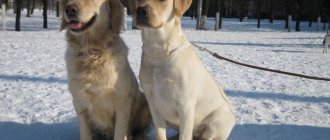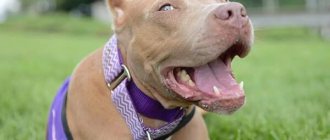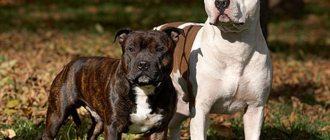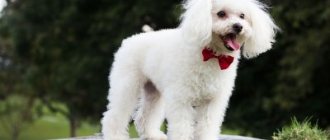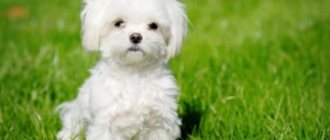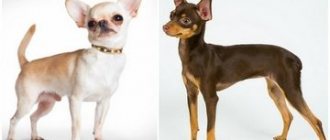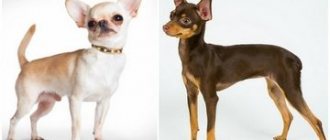History of the origin of breeds
The Labrador and the Golden Retriever belong to the same canine group, Retrievers, but are representatives of different breeds. Labrador was brought to England from the Canadian island of Newfoundland. He helped the fishermen pull their nets and get fish out of them. Actively used as a draft and working dog.
Golden Retrievers were bred by the English Lord Tweedmouth. He set out to get dogs with bright colors so that hunters could distinguish them against the background of peat bogs. His efforts were crowned with success and golden retrievers appeared. They began to be used as gun dogs, which picked up shot birds and brought them to the hunter. This function is reflected in the name of the breed: translated from English, retrieve means to find, return.
Currently, both breeds practically do not participate in hunting. They have retrained as service dogs. Golden and Labrador retrievers have a fantastic sense of smell, which allows them to work in customs and search for prohibited substances. These breeds also serve as guide dogs, rescue dogs, and participate in rehabilitation programs.
Labrador retrievers have an exceptional sense of smell. It is 25% sharper than the German Shepherd.
Possible diseases
Dogs of this breed can be carriers of the following hereditary diseases that arose during the breeding process: diseases of the eyes, bones and joints. Some people experience dysplasia of the hip and elbow joints, which appears due to improper care of the baby.
Dysplasia occurs from an excess of calcium, phosphorus or due to obesity. Retinal atrophy - loss of vision in the dark or complete loss of vision, occurs due to heredity or can be acquired.
On average, pets live about 10 or 12 years. For a dog this is a relatively short period of time. Short life expectancy is also associated with a susceptibility to cancer.
Main types of colors (photos)
There are 3 most popular and standard-recognized types of colors for Labrador Retrievers:
Black
The black color of this dog should be uniform. This color is considered classic. The eyes of a representative of this shade are hazel or dark. The presence of any other spots on the coat is not allowed, only a snow-white spot on the chest is allowed. This is the most ancient color of all, the fur of such Labradors shimmers in the sun, which is explained by the fact that animals of this shade produce more fat in their fur than others.
Pale yellow
This color was included in the standard relatively recently, only in the last century. There are several variations of the shade: golden, pigmented, beige, solid and red fox. There should be no spots on this color. Labradors have fawn-colored eyes and a black nose.
Chocolate
This variation can exist in two shades - dark and light. There are several types of chocolate: liver, light and dark chocolate. A white patch on the chest is allowed. There should be no more light pigmentation on the coat; this is a disadvantage and a defect. The eyes of dogs of this color can be yellow or brown, but the darker their shade, the more purebred the individual is considered.
Male
Male Labradors have the following positive character traits:
- High and constant (no breaks) performance while hunting.
- Impressive appearance for exhibitions.
- Assertiveness in achieving the task set during training or hunting.
Minuses:
- The male is more independent and stubborn. He needs more serious education and training than a bitch.
- Long walks to perform natural necessities. Due to physiology, a male dog cannot quickly empty his bladder.
- Constant reaction to bitches. Possibility of escaping from the owner for this reason.
- The likelihood of fights with other males in the presence of a female in heat.
External differences
The external similarity of the Golden and Labrador is manifested in the light color, hanging ears and massive head. Upon closer examination, these dogs are significantly different. The main characteristics of the breeds include:
- Body type. The Golden Retriever is distinguished by its slimmer shape and lighter bone structure. The Labrador is strongly built and squat. A powerful skeleton speaks of a working nature.
- Coat. Labradors are a short-haired breed. The length of the guard hair should not exceed 5 cm. The pile is shiny, as if waxed, and fits well to the body. The breed standard does not allow waves or feathering. The undercoat of Labradors is abundant and dense, protecting against moisture and cold. The Golden Retriever is known for its long, straight coat. On the limbs, neck, chest and tail, the pile falls in soft waves. The undercoat is thick and abundant.
- Colors. Goldens can come in all shades of gold and cream. Only bright red and mahogany are not allowed. The Labrador color palette is very diverse. The standard allows for black, brown, chocolate and fawn. White color is widespread, but it is considered a defect. According to the standard, white is acceptable as a marking on the chest.
- Tail. The Golden Retriever's tail is large and heavy, with a feathery tail (a characteristic feature of setters). Richly decorated with wool, looks like half a feather, and is a continuation of the line of the spine. Golden does not throw him on his back, he can only lift him slightly. The Labrador's tail resembles an otter's: thick at the base and thin at the tip. The pile on it is short and dense. The dog may raise its tail to show joy, but without curling towards the back.
Despite the differences in physique, the sizes of the dogs are almost identical: the weight of a Labrador reaches 40 kg, and that of a Golden reaches 41.5 kg. The height of a retriever is up to 62 cm, a Labrador is up to 63 cm.
Both breeds are characterized by a range in weight categories: working dogs are usually lighter than their show-class relatives and weigh 26-35 kg.
What to look for
In order not to be disappointed in the future, you need to imagine what a healthy puppy should look like. There is an opinion that it is impossible to guess from a puppy how it will grow up. But you should be well prepared for your choice to reduce the risk of failure.
External signs
A puppy is not yet a fully formed dog, so not all qualities can be assessed in advance. But there are a number of signs that are definitely worth paying attention to:
- Muzzle expression. It is influenced by the structure of the dog’s skull, the location of the eyes and ears. A genuine Labrador has a friendly look. It is not advisable to choose a puppy with eyes that are too close (or, on the contrary, far away), too small or large. Any excessive deviation makes the dog's gaze less pleasant.
- Wool. The outer coat should be hard and the undercoat thick and soft. The undercoat is usually somewhat lighter than the main coat color. Black Labradors are characterized by a gray or black color, chocolate Labradors are dark or light brown, and yellow Labradors are light fawn. There should not be a complete absence of undercoat - this is an obvious defect, since the dog is designed to swim, and the undercoat serves as a water-repellent layer. Long hair is completely acceptable.
- Tail. Reminds me of an otter's tail. There is even a crazy version of the origin of Labradors - from crossing with otters. The standard assumes a medium tail, slightly tapering towards the end. It does not hang below the hocks. There is an opinion that dogs with a short back will have a good tail.
- Body structure. Large head, long neck and deep chest.
Eye color up to 3 months of age is bluish. Over time they darken. Therefore, pay attention to the puppy’s eyes - the darker they are, the darker the adult dog’s eyes will be. The standard allows black, brown and yellow shades.
The most desirable ones are brown and nut.
Assess the puppy’s physique - everything should be normal, nothing should be conspicuous. The body is compact, the loin is short, the skull is wide, and the ribs are rounded—all this a puppy should have.
Important! It is best to choose a puppy at the age of 8-10 weeks. It is highly undesirable to select puppies from large breeds before 8 weeks. Take a closer look at the most cheerful, moderately fattened puppies. They should be well-groomed and not look sad. Pay attention to the puppy's mother - many physical characteristics will be passed on to the puppy from her.
It is advisable to spend at least half an hour alone with the dog - once you are alone with you, away from your brothers and sisters, the puppy may begin to behave completely differently.
Behavior
Take a closer look at the behavior of the puppies in the litter. This behavior will help you predict the character and leadership qualities your dog will develop as he ages.
- at the time of feeding - the most active one will try to get the nipple that he wants, and not the one that is now free,
- during the moments of the game - some bully others, and someone sits quietly in the corner,
- reaction to novelty - release the puppies into unfamiliar territory or throw an object unknown to them and observe.
The most mentally stable puppies are not afraid and look friendly. They are curious - both about unfamiliar people and unfamiliar objects.
It is generally recommended to choose the energetic and most active puppy. But if you are a calm and unhurried person by nature, then perhaps this will be too much for you - it is better to choose a calmer puppy.
When choosing, evaluate the entire litter - if most puppies are inactive, and one is hyperactive, then this is evidence of an unsuccessful litter. Competent breeders try to select parents for mating so that high-quality litters are obtained.
How much does a Labrador Retriever cost?
The most affordable offers are “hand-off” puppies, without documents and pedigree, but we remind you once again: this way you risk becoming the owner of a dog with poor health or completely devoid of the “trademark” qualities of a Labrador due to the admixture of unknown genes. A child with papers who cannot count on participation in exhibitions due to more or less significant defects in appearance will cost from 20 to 35 thousand rubles. Of course, this moment does not matter if you just dream of an affectionate and devoted friend for the whole family.
Dogs of the so-called show class, whose parents are recognized champions, and whose characteristics exactly correspond to the breed standard, are much more expensive - in the range of 40-60 thousand rubles. In this case, you will be able to present your pet to a strict court of experts and hope for prizes.
Purchase rules and tips
If you are choosing a dog with which you want to compete at shows in the future, look for the ideal dog, sparing no time and effort. But if you don’t have such plans and you just need a four-legged friend, then your choice can be a little simpler.
The optimal age for purchasing a puppy is 6-8 months. At this age it is already clear what kind of dog this dog will grow up to be.
Important! You should not save when purchasing - otherwise you risk buying a sick puppy.
Upon purchase you will receive a veterinary passport and a kennel club card. A good breeder will definitely give recommendations on how to get a puppy and will even be ready to advise you after the purchase.
Character
Before deciding who to choose, you need to read reviews about the temperament of Labrador and Golden. Goldens are known for their calm, even-tempered nature. They have an innate sense of tact and will not impose themselves. These dogs are capable of making independent decisions. Before executing the owner’s command, the golden will evaluate its adequacy. If a British person decides that a person wants too much, he may ignore the request. Therefore, retrievers are trained from childhood.
The Labrador is an eternal puppy. He is ready to play all day long and is adored by the whole world. The Canadian gets along well with cats and other animals. But if there are birds in the house, you should not get a Labrador: he will not be able to suppress the instincts of a hunter and will grab the bird. Canadians do not know how to show their emotions. They love to put their paws on their shoulders and knock them down. Labradors need proper training. If the owner indulges the dog, it becomes destructive.
Both breeds are friendly towards strangers. They may leave with the person who offered the treat.
Labradors and goldens are excellent babysitters. The difference is that a Canadian can knock down a child while playing, but retrievers are always careful. Goldens prefer to socialize with teenagers and are ideal for older people. Labradors remain puppies for 3 years. An adult dog does not reduce the degree of activity. Canadians become more reserved only in old age.
Is it possible to influence character and how to correct it?
The upbringing and socialization of a puppy immediately after it comes to your home is of great importance. Do not make allowances for the puppy’s age, do not allow him to chew things, take food from the hands of strangers, pester strangers while walking, pick up pieces from the floor, or beg for food from the table during the family meal.
Strictly forbid jumping on people and biting, even if this is a sign of love. Proper upbringing and training will help change the Labrador's character for the better. When training a pet, training is used using the method of motivation, encouragement, and praise. Cruelty to animals is unacceptable.
Labrador is one of the breeds whose behavior can be corrected even in adulthood. Contact an experienced dog handler for recommendations on how to correct your character, and fully follow the instructions received. The great popularity of the breed has led to uncontrolled breeding of Labradors, which has a negative impact on the health and behavior of the breed. The situation is of great concern to Dog Lovers Clubs and the Fédération Cynologique Internationale (FCI). What is your opinion on this issue?
How to choose a puppy
The popularity of the breed is not always an advantage for those who decide to get a Labrador Retriever. In pursuit of profit, unscrupulous breeders keep parents and puppies in inappropriate conditions. Of course, unsanitary conditions, overcrowding and poor nutrition have a detrimental effect on the development of a growing organism and health in the long term, so the first piece of advice: do not try to save money and contact only nurseries with a good reputation, where you can see your future pet with your own eyes and get acquainted with pedigree documents , get reliable information about vaccinations. When choosing a Labrador, pay attention to compliance with the external characteristics of the breed, observe the baby’s behavior - he should be playful, active and easy to contact. Important signs of good health are a healthy shine to the coat, clean eyes and ears, and a normal appetite.
Breed standards
Before purchasing a Labrador Retriever, get to know what a Labrador looks like.
According to the Fédération Cynologique Internationale, an adult Labrador has the following breed standards:
- the skull is clearly defined, wide, without expressive cheekbones, wedge-shaped. The forehead is slightly convex, blends steeply into the muzzle, and there is a small furrow.
- the muzzle is large and powerful, the nostrils and nose are large and wide;
- the jaws are strong, neat, slightly rounded;
- the nose is straight and even, slightly tapering towards the edge;
- the brow ridges are expressive, but not heavy;
- cheeks are taut, without folds;
- The bite is regular and scissor-shaped. The teeth fit tightly together and are even.
- eyes are small, usually brown;
- the ears are medium in size, triangular in shape, located slightly behind the muzzle, close to the head;
- the neck is strong, lean and powerful; back straight; loin short; the chest is wide and deep; barrel-shaped ribs;
- tail of moderate length, straight; has a larger diameter at the base, narrowing towards the edge; the hanger is missing; the coat is short but thick;
- paws are straight; the hind ones are more developed, have a larger bend angle; metatarsus short; paws of medium size, rounded; fingers pressed tightly, pillows large;
- the fur is hard and short; there is a soft undercoat.
- the height of the dog at the withers is 56-57 cm, girls are several cm less;
- Boys' weight ranges from 27 kg to 40 kg, girls weigh up to 35 kg.
An adult Labrador can have several colors:
- black, a spot on the chest is allowed;
- wheat: from ivory to fox red;
- Brown: The Chocolate Retriever may have a light spot on the chest as standard.
Content
Both breeds are suitable for apartment living. They are people-oriented and want to participate in their owner's life. Ideal living conditions are a private house with a fenced area. Dogs will have the opportunity to run around and burn off pent-up energy.
Labradors and goldens are not suitable for kennel keeping! They are designed to interact with people and will go crazy in isolation.
Labradors and Golden Retrievers are prone to excess weight and therefore need regular exercise. They love frisbee, agility, fetch and swimming. Goldens require regular grooming. It is combed for at least 15 minutes daily. Especially after walking. The Briton sheds all year round with short breaks. The heaviest shedding occurs in spring. The Labrador's coat is much shorter, so he is brushed every 3 days. He also sheds throughout the year.
Both breeds do not require grooming or frequent bathing. Dogs are washed with a special shampoo no more than 2 times a year. The rest of the time they are wiped with damp towels and rinsed in the shower. Labradors and goldens love to swim, so you can take them to the pool and to the river.
The ears of lop-eared dogs are especially vulnerable. Their closed nature promotes the development of infections, and during walks they become clogged with debris. Therefore, they need to be inspected every day and cleaned if necessary. The procedure is carried out using a cotton pad soaked in warm water, or washed with a special lotion. Eyes are also rubbed as needed. A cotton pad is moistened with warm water or chamomile infusion. Movements during brushing should be directed towards the corner of the eye.
The first estrus in these breeds begins between the ages of 8 months and 2 years. Usually there are no more than 2 heats per year. The first mating should take place when the female reaches the age of 20 months, the male 18. The most favorable moment for mating is the 10-15th day of estrus.
On average, a Golden Retriever lives 10-12 years. He is susceptible to cancer and hip dysplasia. Canadians enjoy better health. Labrador retrievers live about 10-14 years, more often - 15.
Feeding
Labrador and Golden Retriever are active, cheerful dogs. To restore energy reserves, they need the right diet. Both breeds can be fed natural and dry. The choice of food type depends on the preferences of the owner. Modern super-premium dry food does not harm the health of the animal and is made from whole meat. The Labrador and Golden menus are the same.
A diet based on natural products includes:
- dietary meat (beef, horse meat, lamb);
- boiled offal (liver, tripe, kidneys, udder);
- boiled sea fish;
- cottage cheese, kefir, yogurt;
- rice, buckwheat;
- boiled chicken eggs (2 per week);
- cabbage, carrots, zucchini, pumpkin;
- seasonal fruits;
- greenery.
Dogs are fed morning and evening. Meat should account for 50% of the daily portion. It can be given raw, scalded with boiling water or boiled. The amount of meat is calculated as follows: 15 g of meat per 1 kg of animal weight. Sea fish is given 3 times a week. Her head, tail, fins, bones and organs are removed. River fish is given only boiled: it can be infected with worm eggs.
List of prohibited products:
- fatty meat (pork);
- poultry tubular bones and boiled bones;
- potato;
- legumes;
- milk;
- sausages, bakery, confectionery products;
- fried, salty, spicy;
- seasonings and spices.
Natural feeding should be supplemented with a vitamin complex. The veterinarian picks him up.
Dry food must be at least premium class. It is better to use super premium products. Feeds with fewer “stars” are made from offal and contain flavor enhancers. The most famous premium products include Hills, Royal Canin and Pro Plan.
Super premium food is made from natural ingredients: first-class meat and vegetables. Among them:
- Akana;
- Nutra Gold;
- Bosch;
- Pronature;
- Go!;
- Naw!;
- Orijen;
- Grandorf;
- Innova.
Recommendations for the volume of daily servings can be read directly on the packaging or the manufacturer’s website.
Both breeds are prone to excess weight, so they should not be overfed.
Keeping and caring for a Labrador at home
The dog should be brushed several times a week with a rubber brush. Several times a year or as necessary, the dog will have to be completely bathed, but without using detergents. If your dog gets dirty during a walk, you can wipe it with a damp terry towel. You should check and wipe your pet's ears daily, as they can accumulate dirt and bacteria.
Spend at least 40 minutes walking twice a day. You need to play active games with the dog and, if possible, “exhaust” it with commands. The simplest commands “fetch” and “give” must be taught to your pet. During a walk, the dog should run and play plenty, since a sedentary lifestyle leads to rapid weight gain.
Puppies are even more active and inquisitive than adults. If the owner does not play with the dog, he will certainly have fun on his own. If the owner does not at all share the tastes and desires of the pet, the dog may leave its owner out of boredom.
Keeping a Labrador retriever is not particularly difficult. From childhood, teach your dog discipline: the bed is not for the dog, lunch is on time, you need to wait until you go to the toilet until you go for a walk. The Labrador Retriever is a very smart and quick-witted dog. He will understand you and remember everything. Be patient and get ready for the fact that up to 3 years old the dog will frolic and have fun in every free minute.
Diet
Each owner has his own preferences in feeding his pet. Some believe that dry food is more suitable for a Labrador, while others choose a natural diet. The only correct solution in this case is not to mix two types of feeding at one meal. Dishes made from natural products will cost the owner less, dry food does not require processing, and is suitable for busier owners.
A puppy up to 3 months is fed 6 times a day, up to 5 months - 5 times a day, up to 10 months - 4 times a day, up to a year - three meals a day, and after that - only two meals a day.
These dogs love to eat, their body is predisposed to obesity, so you need to carefully monitor their diet and portion size.
Some breeders advise that even with dry feeding, you should still add fresh foods to your pet’s diet: beef, vegetables, lean fish, etc. The dog's diet should be balanced and filled with all the vitamins and minerals necessary for the growth and development of the animal. A good 30% of the dog’s menu is allocated to meat dishes. Therefore, pay attention to the composition of the dry food you purchase.
It is better to choose bowls for your pet from stainless steel; they are more durable and convenient for both the dog and you, since you will have to wash them daily. It is recommended to hang the bowls on a special stand so that the dog does not stretch his muzzle to the floor.
If you just brought your puppy into your home, feed him his usual food for a few days to reduce the stress of the move. Later the diet can be changed.
It is recommended not to add the following foods and dishes to your dog’s diet:
- sweet and savory products;
- fatty foods;
- tubular bones;
- potatoes, pasta;
- cow's milk;
- leftovers from your table.
If your pet's diet is composed correctly, this will be visible in the condition of its coat.
Girl or boy?
Both girls and boys make excellent companions. However, the nature and content of representatives of different sexes have their own characteristics, which should be taken into account when choosing.
Boys are usually bred for show careers, hunting or search and rescue. They do not go into heat, have no forced breaks for pregnancy and caring for their offspring.
However, males have a more obstinate disposition - it will be more difficult for novice dog owners to cope with them. When meeting a female in heat, boys lose their composure and can run away after the “lady” they like.
Girls are usually more flexible. They have a developed maternal instinct, so they become excellent nannies for their master's children. Thanks to their calm nature, they are easier to train - they do not strive to take a leadership position and obey all family members.
The owner of the girl will have to come to terms with regular estrus, which occurs twice a year. And although Labradors are very clean, during this period the female may accidentally stain furniture or things.
To avoid unwanted pregnancy, during heat the dog will have to be kept on a leash during walks and pushy suitors will have to be driven away from it. If the owner decides to have offspring, he will need to find a worthy “groom”.
For your information. During pregnancy and after childbirth, females need special care, which requires some experience and skills.
It should be remembered that every dog is individual. Among boys there are calm and gentle individuals, and among girls there are cocky and wayward ones. Therefore, it is simply impossible to answer unequivocally in favor of whom to choose.
How to choose a nursery and a good breeder
First you need to decide on a nursery where you can buy a puppy. Surely, puppies are also sold on the market, but a good nursery is a great guarantee of the purebred puppy and high-quality conditions for its health. When purchasing puppies from a kennel, you can find out their pedigree. This point is extremely important for people who plan to participate in various exhibitions with their Labrador. If you can, go to a dog show where you can meet breeders or someone who can recommend a good breeder. You might even be able to buy a puppy at the show itself.
Important! In addition to the nursery, it is important to evaluate the breeder himself. A good breeder loves his dogs. He will be happy to show you where the puppy and its parents are kept, and will help with advice on raising it. Based on what you see, it will be possible to understand whether the puppy is at risk for hereditary diseases, the development of which depends not only on the puppy’s parents, but also on its nutrition and care.
Education and training
Labradors and Golden Retrievers begin to be trained at an early age. Puppies are weaned from biting, stealing food from the table, and pulling on the leash and collar. They are also taught to have order and use the toilet outside. Labradors and goldens are very smart and easy to train. They strive to earn the approval of their owner, so they quickly remember commands. The only disadvantage of both breeds is absent-minded attention. They may become distracted by games and lose interest in training.
Labradors and Goldens are sensitive to criticism. Training should be based on praise and encouragement.
Both breeds require professional training. A puppy that has been worked on by a trainer will grow into a well-managed dog. Goldens and Labradors tend to sit on their necks, so it is best to raise them under the supervision of a professional.
Negative traits
Negative character traits of a Labrador Retriever include:
- intolerance of loneliness;
- damage to things and objects as a result of hyperactivity, insufficient or poor upbringing, stress.
However, all the disadvantages of the Labrador’s character given in the description can be corrected by raising the dog correctly. The breed needs increased attention and love. Often negative behavioral traits of a Labrador appear in the absence of care on the part of the owner.
Positive features
The description of the Labrador Retriever breed fully gives an idea of the “golden” character of the dog. The breed is well suited for large families with children and inexperienced dog breeders . The advantages of the breed include:
- the undiminished cheerfulness of dogs;
- great love and devotion to the owner, all households, including other pets;
- lack of aggressiveness;
- good intelligence and obedience (after appropriate education and training);
- sincerity and ability to adapt to each family member.
Bitch
It is believed that female Labradors have a more obedient, flexible character. According to experts, this statement is highly controversial. The character of a puppy depends on personal qualities and heredity. However, there is a difference in the behavior of the sexes. There are pros and cons to both female and male puppies.
Pros of a female Labrador:
- Great affection for home and owner.
- The female is distinguished by increased intelligence and higher intelligence.
- A female puppy perceives everything more subtly on an emotional level.
- Easier to train.
- During walks he runs less into the bushes.
- Does not get involved in showdowns with other dogs.
- More suitable for breeding the breed. Only one evaluation from the exhibition is required.
Negative points:
- Cunning.
- Periodic heat.
- If a puppy is purchased for exhibitions, then in appearance and size the female is inferior to the male.
Classification of names
If the question arises of what to name a boy’s Labrador, then here you can pay attention to foreign names, for example, Austin, Tom, Jerry, Jack. As for girls, the most commonly used nicknames are Janie, Michonne, and Shawl.
Nicknames for Yorkie boys and girls: what to name
A nickname for a dog can be inspired by characters from movies, cartoons, and they can also be found in the geography atlas, for example, Vistula, Tula, Marne and others.
Nicknames given in honor of famous people such as Churchill and Spartak sound unusual and interesting. If the dog is active, energetic and playful, it can be called Smerch, Tornado, Mercury.
Worth knowing! Names that carry a hidden meaning include Lucky, Hart, Roger, Lorna and others.
Accustoming to home environment
Keeping a Labrador at home does not require complex skills or special training, but the first days of a puppy in the house are not easy for everyone. Moving is a huge stress for a baby - new smells, absence of mother and relatives, unfamiliar people.
In such a situation, the pet becomes nervous, whines, and may refuse to eat at first. There is no need to give your little lab sedatives; the stressful state will go away in 3 to 4 days.
Toys for baby
In the first days of the Labrador’s stay in the house, it is better for the owner to be close to him: talk to the puppy, play, feed him by hand and not leave him alone for a long time. If you can’t constantly be near your pet, you should definitely leave him toys or chewy treats. Thus, the baby adapts faster and gets used to new people and places.
The biggest problem for owners is the puppy's first night in a new home. A small Labrador will definitely whine all night - everyone who gets a dog has gone through this. To ease the situation, you need to pick up your pet from the breeder in the morning. During the day he will get used to the new surroundings a little, people and the night will pass more calmly.
You should not leave your Labrador alone on the first night in an empty dark corridor, this will scare him. Let the dog bed lie next to the owner's bed for the first time, so that at night you can simply put your hand down and cheer the baby up.
Otherwise, when a frightened dog howls, the owner will still have to get up and take the frightened animal home. The puppy will definitely remember this act and will “call” you for more than one night. It is better to teach one pet to sleep gradually.
Character development with age
- The Labrador puppy is very simple-minded and sincere. He likes to run and play pranks, and can chew things. Proper upbringing and training make it possible to ensure that your pet will not misbehave. The desire to chew things is not a sign of bad character , the baby is hyperactive and needs to pour out his energy somewhere. Buy him toys, he will direct his activity towards them. At the age of 3-4 months (the period of socialization), the little Labrador masters the general course of education.
- During the transition from puppy to adult, the Labrador becomes somewhat calmer. This period is considered to be adolescence and lasts up to 3 years. Before committing an act, the pet comprehends it. At this time, socialization and training of the dog is of great importance.
- In old age, the Labrador's behavior changes somewhat . He still loves everyone around him and is friends with them. But due to deterioration in physical and mental well-being, various changes in behavior are possible. Labrador retrievers become less energetic as they age and require less activity. Older dogs sometimes develop separation anxiety, especially if there is no one in the house during the day (the family is working). If there are family members nearby, such fear does not arise. Due to age, hearing, vision or smell may deteriorate. Your Labrador may develop noise sensitivity and may experience stress due to changes in his home environment. With all changes in the health and psyche of your pet, you need to contact a specialist in a timely manner.
